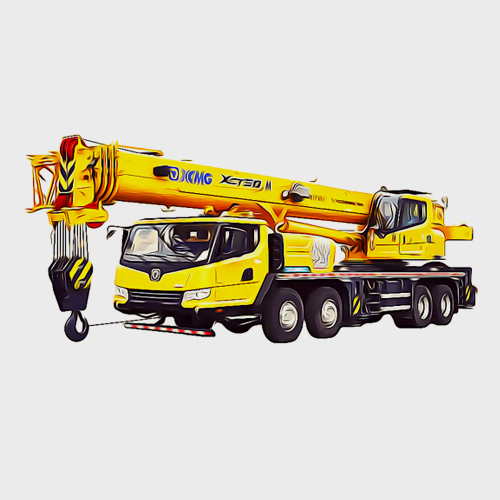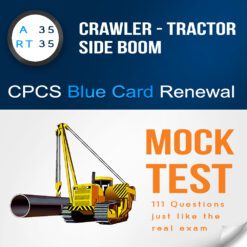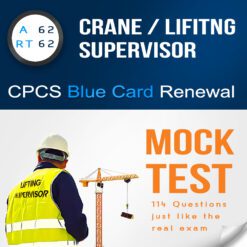1. Why is a greater distance from power lines required for higher voltage lines?
A) To avoid potential crane malfunctions
B) To decrease the power line’s visibility
C) To showcase the crane’s precision
D) To reduce the risk of dangerous arcing
Correct Answer: D) To reduce the risk of dangerous arcing
2. What determines the frequency of checks and inspections for a crane’s maintenance?
A) Manufacturer’s recommendations
B) Operator’s discretion
C) OSHA guidelines
D) Site manager’s instructions
Correct Answer: A) Manufacturer’s recommendations
3. What is the significance of all personnel, including the operator, taking note of the lift plan contents?
A) To avoid lift plan requirements
B) To report discrepancies or missing elements in the plan
C) To save time during the lifting operation
D) To solely rely on the lift planner’s instructions
Correct Answer: B) To report discrepancies or missing elements in the plan
4. What is the purpose of traffic warning or prohibition signs placed on or near bridges?
A) To display nearby tourist destinations
B) To show the current weather conditions
C) To indicate the maximum permitted vehicle height
D) To highlight historical facts about the bridge
Correct Answer: C) To indicate the maximum permitted vehicle height
5. What is the importance of a mobile crane being level both longitudinally and laterally during a lift operation?
A) To ensure a smoother lifting process
B) To enhance operator visibility
C) To prevent side loading on the boom or jib
D) To showcase the crane’s adaptability
Correct Answer: C) To prevent side loading on the boom or jib
6. What potential issue might arise with loads having a large surface area in high winds?
A) Movement or swinging that could cause the crane to go out of radius
B) Changes in load weight distribution
C) Hoist rope alignment with the boom
D) Increased hoist rope visibility
Correct Answer: A) Movement or swinging that could cause the crane to go out of radius
7. Why are minimum distances specified when working near overhead power lines?
A) In case power lines are cut
B) To prevent fire hazards
C) For lightning strike protection
D) To avoid electric arcing
Correct Answer: D) To avoid electric arcing
8. What does the requirement for the hook to be directly above the center of gravity ensure during lifting?
A) Decreased load stability and control
B) Enhanced weight distribution of the load
C) Increased strain on the crane’s mechanisms
D) Maintains the load’s stability and prevents swaying
Correct Answer: D) Maintains the load’s stability and prevents swaying
9. Why is it crucial to segregate the area of lift and the area of placing the load from pedestrians?
A) To increase the efficiency of the lifting process
B) To prevent interference with the lifting operation
C) To encourage public engagement with the process
D) To minimize the crane’s workload
Correct Answer: B) To prevent interference with the lifting operation
10. When does a crane’s rated capacity apply?
A) For freely suspended loads
B) Only for static lifts
C) For all lifts
D) Based on the experience of the operator
Correct Answer: A) For freely suspended loads
11. What causes costly incidents involving mobile cranes becoming unstable?
A) Insufficient planning
B) Driver error
C) Lack of maintenance
D) Manufacturer defects
Correct Answer: A) Insufficient planning
12. What needs to be thoroughly planned before setting up a mobile crane?
A) The number of loads to be lifted
B) The lifting accessories to be used
C) Ground conditions and the working area
D) The number of personnel required
Correct Answer: C) Ground conditions and the working area
13. What indicates the minimum distance from a trench edge?
A) The load weight
B) Visible ground cracks
C) Twice the trench height
D) The slew radius
Correct Answer: C) Twice the trench height
14. What is often done when moving a crane between locations on site?
A) Fully de-rig the crane
B) Partially de-rig the crane
C) Extend the outriggers
D) Disconnect power sources
Correct Answer: B) Partially de-rig the crane
15. How can driving on temporary roads affect mobile crane stability?
A) Edge collapse hazards
B) Poor visibility from cab
C) Increased tyre wear
D) Limited acceleration
Correct Answer: A) Edge collapse hazards
rt60 mock test, rt60 practice test, rt60 test questions, rt60 exam questions, rt 60 mock test, rt 60 practice test, rt 60 exam questions, a60 mock test, a60 practice test, a60 exam questions, mobile crane mock test, mobile crane practice test, mobile crane test questions, mobile crane exam questions, cpcs mock test, cpcs practice test, cpcs test questions, cpcs exam questions, nocn mock test, nocn practice test, nocn test questions, nocn exam questions, citb mock test, citb practice test, citb test questions, citb exam questions, blue card mock test, blue card practice test, blue card test questions, blue card exam questions













































